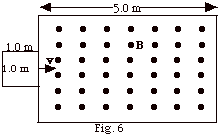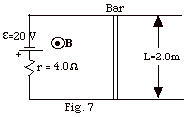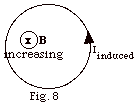|
|
|
1.
|
A magnet moves toward a coil of wire
and the current is induced in the sense shown in Fig. 1 below.
Is the pole of the magnet closes to the coil acting as a north-seeking
or south-seeking pole?

|
|
|
2.
|
A bar magnet drops through a conducting
loop. Will the acceleration of the bar magnet be constant?
Explain your answer.
|
|
|
3.
|
A square loop of wire, 2.0 meters on
a side, has a resistance of 0.04 ohms. The loop is in a horizontal
plane. Initially, a magnetic field B = 0.080 N/A-m points
vertically downward into the loop. If this field is reduced
in magnitude to 0.040 N/A-m at a constant rate in 2.0
s, find the direction and magnitude of the induced current.
|
|
|
4.
|
A loop of wire acde
in Fig. 2 below moves to the right in the magnetic field of
a very long current-carrying wire. Is there an induced current
in the loop for Fig. 2a and Fig. 2b? If there is an induced
current, what is its direction?

|
|
|
5.
|
A circular metal chain in a horizontal
plane is in a vertical magnetic field upward. The chain has
a resistance of 0.001 W
and its length is 0.40p
m. (a) If the magnetic field increases from 0.010 N/A-m to 0.060
N/A-m in half a second, find the current that is produced
in the coil. (b) Draw a diagram of the chain and field, and
indicate the direction of the current in the chain. (c) Does
the chain tend to expand or contract while the magnetic field
increases? (d) When the field becomes steady at 0.060 N/A-m,
the chain is withdrawn in 0.30 s. What average current is
produced while the chain is withdrawn? Draw a diagram indicating
the direction of the induced current. Does the magnetic force
on the chain hinder or aid the withdrawal of the chain from
the field?
|
|
|
6.
|
A loop of wire rotates with a constant
angular velocity w in
a constant horizontal magnetic field B. At any instant,
the angle between the magnetic field and the normal N
to the surface of the loop is Q
= wt. Write an expression for (a) the magnetic flux
through the coil and (b) the emf induced in the coil at any
instant. What is the value of Q
when (c) the magnetic flux and (d) the emf is a maximum?

|
|
|
7.
|
Figure 4 below shows a conducting rod
of length L being pulled along horizontal, frictionless, conducting
rails at a constant velocity v. A uniform vertical
magnetic field B out of the page fills the region in
which the rod moves. Find (a) the magnetic flux when the rod
is a distance x from the left end of the conducting rails,
(b) the change in magnetic flux when the rod moves
to the right a distance D x,
(c) the induced emf e ,
(d) the direction of the induced current, (e) the induced
current in the loop of total resistance R, (f) the power dissipated
in the resistance R in terms of B, L, v, and R, (g) the force
that must be applied by an external agent to maintain the
motion, (h) the power supplied by the external agent, and
(i) a comparison of the answers to (f) and (h).

|
|
|
8.
|
A bar of mass m = 0.50 kg slides downward
along stationary wires that are separated by a distance L
= 0.5 m and are joined at the top by a resistance R = 0.010
W (Fig. 5 below). A uniform
magnetic field B = 0.20 N/A-m points into the paper. (a) If
the bar slides down, what is the sense of the current through
it? (b) At what speed v will the bar experience no force?

|
|
|
9.
|
A square loop of wire 1 m on a side moves
with a speed v = 0.5 m/s into a region of a magnetic field
B = 1.0 T out of the page, as shown in Fig. 6 below. At t
= 0, the loop of wire is just about to enter the magnetic
field. (a) Plot the magnetic flux through the loop of wire
as a function of time at 1-s intervals for 12 s. (b) Now plot
the induced emf in the coil for the same time and interval
of time. (c) If the coil has a resistance R = 0.01 W
find the induced current in the coil at the various
times. Describe the sense of the current as the coil passes
through and out of the field.

|
|
|
10.
|
A conducting bar rests across horizontal
tracks that are connected on the left by a battery of emf
= 20 V and internal resistance r = 4 ohms (Fig. 7 below).
The tracks are separated by a distance L = 2.0 m. A magnetic
field B = 0.10 N/A-m points vertically upward.
If the magnetic field is increased to 1.10 N/A-m at a uniform
rate over a period of 0.10 s, how far from the
left end of the rails must the bar be placed at rest in order
to experience no net force?

|
|
|
11.
|
In Problem 10, if B remains constant
at 1.10 N/A-m, at what constant velocity v (magnitude and
direction) will the bar experience no net force?
|
|
|
12.
|
In Fig. 8 below, a circular wire encloses
a magnetic field into the page that is increasing. There is
an induced current in the wire counterclockwise to oppose
the change that produced it. Can you think of this as changing
magnetic flux producing an electric field, which, in turn,
produces a current? If so what is the direction of the electric
field. Would, then, a changing magnetic field produce an electric
field, even if a circular wire were not in this space?

|
|
|
13.
|
A positively charged particle moves
in a circle of radius R in the plane of the page with velocity
v when a magnetic field B is into the page. (a) If the magnetic
field is increased, will the speed of the charged particle
remain the same increase, or decrease? (b) Will your answer
be the same if the magnetic field is out of the page and increasing?
(c) If it is out of the page and decreasing? (d) If the particle
is negatively charged and the magnetic field is into the page
and increasing? Explain your answers.
|
|
|
14.
|
A rod with length L, mass m and resistance
R slides without friction down two parallel conducting rails
inclined at an angle Q
with the horizontal. The rails and the bar that connects them
at the bottom of the incline have negligible resistance. Find
the constant velocity v achieved by the wire in a uniform
magnetic field B directed vertically upward.
|
|